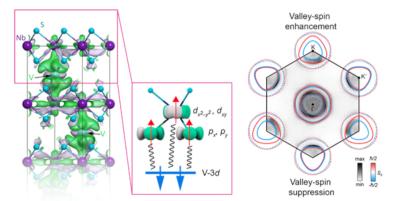An international team of scientists led by a group at the University of St Andrews and the University of Manchester, report on a giant valley-selective Ising coupling in the surface layer of an intercalated transition metal dichalcogenide, V1/3NbS2.
Using angle-resolved photoemission spectroscopy measurements, the researchers proved the surface electronic structure of the semimetal. The researchers discovered an alternating pattern of enhancement and quenching of valley-spin polarization of the host NbS2 layers due to the intercalated Vanadium ions, equivalent to the application of a 250 T magnetic field. The researchers say that this is a major step forward in valleytronics, opening up new opportunities for the development of advanced electronic devices.
